THE BEAUTIFUL YEARS
(Vol. I of The Flax of Dream)
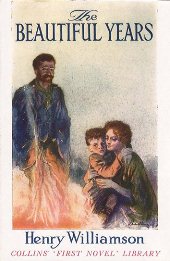 |
|
| First edition, Collins, 1921 |
First published by Collins, 1921 (price 7/6d), 750 copies
Revised edition Faber & Faber, 1929
Dutton, USA, 1929
Many reprintings and foreign editions
Currently available from Faber Finds
The Beautiful Years, the first volume of The Flax of Dream, was HW’s first book. In the hierarchy of The Flax of Dream it represents ‘Childhood’. The writing of this first book did not come easily and there were many false starts. Demobilised on 9 September 1919, but very traumatised by his experiences of the First World War, HW was living at home surrounded by his stern over-critical father (himself exhausted by his war duties as a special constable on top of his job as a bank clerk) and his rather cloying, sentimental, seemingly ineffectual and fearful mother, plus his two sisters between whom and with whom there were constant quarrels.
The first full version of the book was written during the summer and autumn of 1920 when, after a brief stint in the advertising department of The Times,HW was employed as a reporter working for the Weekly Dispatch (mainly writing a ‘car notes’ column). In order to escape the family he found so stifling, and so as to write in peace, he borrowed a bedroom in his (maternal) grandfather’s house next door – the two houses were semi-detached; as a child he would enter it via the attic trapdoors – and wrote there at night. This, and his general behaviour at that time, added to the further annoyance of his father.
HW had become a member of The Tomorrow Club, a literary society formed to help promising writers by Mrs Marjorie Dawson Scott, who later formed the great literary society PEN. There he met the leading writers of the day, John Galsworthy, J. D. Beresford, Walter de la Mare, all of whom were encouraging and supportive, and also such luminaries as George Bernard Shaw. He was lucky in finding a sympathetic agent very early on, Andrew Dakers, who was always supportive and encouraged this diffident writer through all his changing moods of nervous despair and wild hopes. J. D. Beresford, reader for the publishers W. Collins Sons & Co., also read the manuscript, and although he suggested several changes, recommended the book to his employers. By February 1921 a contract had been signed and an advance of £25 paid. This gave HW a measure of confidence in himself as a writer, and he decided to go and live in that little village on the North Devon coast that he had visited just before the First World War broke out and which he had felt was his spiritual home.
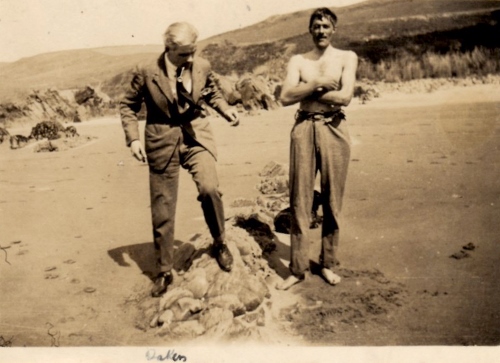 |
| HW and his agent, Andrew Dakers, on Putsborough Sands in May 1922 |
It has been stated that HW fled to Devon after a final quarrel with his father, but, teasing out various pieces of evidence over many years of research, it has become apparent that this was actually a planned move, viable at that moment because he had had his first book accepted; which does not negate the fact that life with his father was indeed very strained. He arrived at Skirr Cottage (so named by him because of the owls that lived in the roof rafters) in Georgeham with absolutely perfect timing on 21 March, the equinox and the first day of spring: a day that epitomises hope and renewal of all things good in this world, when the sun returns to warm the land and all nature responds. One feels that the date was deliberately chosen!
It is evident that HW rewrote much of the book at this stage according to Beresford’s advice, and presented the finished typescript to the publishers in June, when he received a further £25.
The Beautiful Years was published at the beginning of October 1921 and he received another £25, £75 in total. On a book costing seven shillings and sixpence with a print run of 750 copies, this advance of £75 represented a substantial commitment by Collins to their budding new author, for even if the entire print run sold through – which it didn't – their total gross income would be £281 5s (in present day values, £75 approximates to £2,600). HW always gave the impression that his early books were failures and made no money; while they may not have sold enough copies to give him additional royalties, his advances were certainly generous.
The dedication reads: ‘In deep affection to my Mother and my Father, this story of far away and long ago is given.’ ‘Far away and long ago’ is a reference to W. H. Hudson, one of HW’s most important mentors; while the quotation from Richard Jefferies on the title page, ‘The sun shone there for a very long time and the water rippled and sang . . .’ pays homage to the most important.
The Beautiful Years tells the story of a lonely little boy, Willie Maddison, whose mother died in giving birth to him, growing up in the family home, Fawley House, in the quiet countryside of Rookhurst, set in the West Country at the turn of the last century, in the care of a father so wrapped up in his own grief that he is stern and cold to the highly strung child, loving him but unable to communicate his feelings – and thus alienating the child. Willie finds refuge in the countryside around his home and comfort in the faithful but simple care of Biddy, the family housekeeper, but he is wild and impish in his ways.
Willie has a stolid friend of his own age, Jack Temperley, son of a neighbouring farmer living at Skirr Farm, who shares his adventures. He gets to know Jim Holloman, the crow-starver (a man employed to frighten the birds from the crops) who chooses to live rough and is considered to be uncouth and wild, even ‘mazed’ (slow-witted or even bewitched), by the local worthies, but who is actually gentle and knowledgeable of country ways and wildlife. Jim has a simple idealistic love for Dolly, the maid at the Temperleys’ farm.
Willie himself at the tender age of nine feels the first stirrings of calf-love for Elsie Norman, daughter of a well-known artist living nearby, and we meet her friend, Mary Ogilvie who comes to stay from her home on the North Devon coast, and who is to play a major role as the novels progress.
Towards the end of the book, Willie is told that he is to attend ‘Colham’, the local grammar school: news that fills him with fluttering terror. But the volume ends with one of Willie’s escapades when, out with his friends plaguing the gamekeeper, he gets caught. To avoid his father’s anger and the inevitable beating, he runs away from home to live wild with Jim Holloman. But Jim’s sudden and unexplained disappearance overnight enforces Willie to return home and on his tenth birthday, which for his ever-anguished father is the tenth anniversary of his beloved wife’s death, there is a tense attempt at reconciliation and forgiveness.
*************************
The Beautiful Years is in many ways based on Henry Williamson’s own early life, although the background is transposed from his real south-east London childhood to a rural (unspecified) West Country location. His own father was equally as sternly Victorian as his fictitious counterpart John Maddison, although his own mother did not die in childbirth. Jim Holloman, the ‘rapt English rustic’ is based on – and is a tribute to – the great country writer Richard Jefferies, whose mystical book The Story of My Heart had catapulted Henry Williamson through the barrier of his own fearful psyche when he read it while still in the army at Folkestone in early 1919. It confirmed his determination to be a writer in the tradition of Richard Jefferies and W. H. Hudson, Thomas Hardy and John Galsworthy. HW was very influenced by Jefferies and this is obvious in the early writings. There is even a ‘Longpond’ in this novel as in Bevis, Jefferies’ own tale of boyhood: a three-volume copy of which was handed down to HW from his grandfather via his father – and is still in his archive. HW also kept a large folio Journal at this time, dedicated to Richard Jefferies, and constantly referring to the guidance of his spirit on his own life.
Jack Temperley, Willie’s stalwart friend, is mainly based on HW’s cousin, Charlie Boon, who lived with his family (relations of Henry’s mother) at Aspley Guise, Bedfordshire, where as a child young Henry spent some happy holidays. There is, however, also a large element here of his great childhood friend in Lewisham, Terence Tetley, (who features large as Desmond Neville, friend of Phillip Maddison, in the later series A Chronicle of Ancient Sunlight). Other boys in the novel are recognisable from real life, and these have been identified in various other HWS publications. The adventures that the boys have are based on real events that happened to Henry himself in his own childhood. For instance, HW won a scholarship to the prestigious local grammar school, Colfe’s, run as a minor public school, and the boys were very competitive over birds’-nesting and egg-collecting. Elsie Norman is based on HW’s first childish romance with the girl who lived at the top of his road in Lewisham, Doris Nicholson (who reappears as Helena Rolls in the Chronicle). HW as good as tells us this (not that his readers would have known) in a passage in the first edition that he excised, perhaps sensibly, when re-writing and preparing the revised version. The young Willie has just met Elsie for the very first time:
He sighed. It was useless. She would be gone to-morrow. At any rate he would go and tell Jack: he would understand. He was in love himself with Miss Nicholson, who had a bulldog, and played the new organ in the church. Although, of course, Jack wouldn’t understand; Miss Nicholson was not so pretty like . . . like her on the stile.
And this was the first meeting of William Maddison and Elsie Norman; for whom later he was to weave, poet-like, the Flax of Dream – a sad tapestry. For usually the first love of poetic youth is as ephemeral as it is radiant, the attraction of like for the unlike.
Mary Ogilvie, in this novel based on his friendship with Doline Rendle (whom he desperately loved, but she only felt friendship), goes on to play a major role as the series progresses.
Jim Holloman, as mentioned, is a portrait of Richard Jefferies: HW stated that he lifted the description directly from Walter Besant’s biographical tribute to his friend. But when HW stayed with his cousin Charlie Boon at Aspley Guise as a boy, they knew a local lad named Jim Holliman, who was a crowstarver: he was also killed in the First World War, and his name is on the village war memorial along with Cousin Charlie’s. The death of Jim Holloman in the novel symbolises Jefferies' own early death (as Jim would have choked on the fumes of the lime-kiln as he fell into it – so Jefferies choked to an early and untimely death through TB). But I think there is perhaps an even greater symbolism here: this death is meant to represent all those untimely deaths of the so recent war. Jim and Dolly were happy in their simple innocent way: his death came without warning, taking away their future – symbolically as the many thousands who died on the Front Line.
The scenery and locations described in the novel are very obviously those of Georgeham and its surrounding countryside (for instance, the clay pits which claim Jim Holloman’s life are particularly recognisable) but the overall fictional placing of the Maddison family home is extremely vague in the Flax of Dream novels, and it is not until HW’s return to this location in the later Chronicle of Ancient Sunlight that we learn it is actually near Salisbury in Wiltshire (and has recently been exactly pinpointed). But although based on these realities, there is a great deal of artistic structure in the book, and together with the descriptions of wildlife and the countryside (Henry Williamson’s forte), and the simple but moving story-line, the author gives a rich and fine picture of a vanished time of country and village life.
By the time HW had written the final volume of The Flax of Dream (The Pathway) in 1928 he felt this first volume was too raw and unformed and not worthy of his more mature grasp of style, so he polished and honed the text, excising the worst of the somewhat sentimental childish phrases. Also removed were the charming original chapter headings which set the book so well into its era. The new edition was published by Faber & Faber in 1929: and in the same year it was also published by Dutton in the United States, to great acclaim. But what is needed now is a new edition which combines both versions.
When it was first published (on 13 October 1921), the book was hailed as a novel of unusual distinction and beauty, stamping its author as a true poet of nature, a book of rare simplicity and deep insight. S. P. B. Mais, himself a prolific writer and who went on to be a life-long friend of HW, reviewed the book in the Daily Express on 22 October:
. . . a first novel of quite unusual distinction and beauty, stamping its author, Mr. Henry Williamson, as a true poet of nature. To read this ‘April’ novel is to be drenched with apple-blossom, to believe again in idyllic romance, to be lifted momentarily clean out of the atmosphere of foggy drabness which surrounds most novels, and to be set down in a land where life can be seen through the eyes of a child. These are, indeed, very beautiful years. Mr Williamson has also the rare merit of being accurate in his psychology of childhood, the Devon dialect, the way of a man with a maid, and in his scenic setting.
That the book was well received in general can be seen by the following fairly typical remarks: ‘a book of moving poetry’; ‘a labour of love’; ‘memorable’; ‘real literature’. Today these words are even more applicable. One is drawn into a world that has long disappeared: one recognises the authenticity and truth of the picture the author paints.
The Bookman, in its lavishly illustrated bumper Christmas issue for 1921 carried both Collins' advertisement for the book and a review that recognised HW's talent for writing:
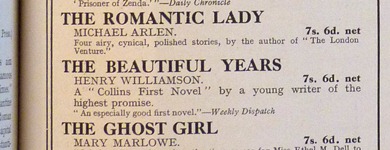
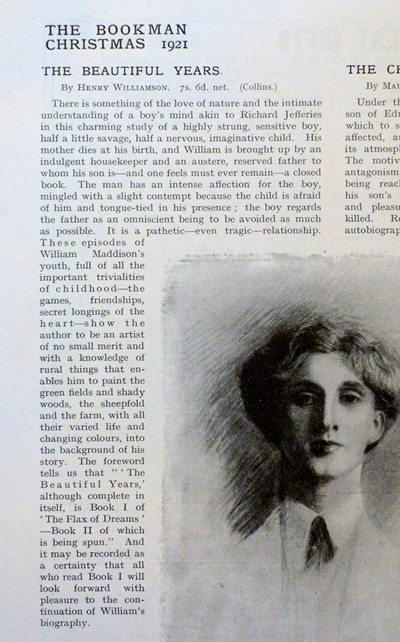
It was American reviewers, as is shown by a large file of cuttings, who really took the book to heart (but we must remember that this was the revised 1929 version – and HW had very recently had a storm there with Tarka the Otter and The Pathway).
Herschel Brickell in the New York Tribune headlined it as the ‘Childhood of a poet’.
Sidney Williams (widely syndicated across America in many state and township newspapers) found it ‘a touching and at times very amusing revelation of unfettered childhood’.
John Clements stated: ‘The beauty of nature unfolding with the changing seasons, observed minutely and with perfect understanding by a writer who makes melodies of words . . . The beautiful language used, the simplicity of style, clearness of description, poetic treatment and naturalness, make the book one to read and re-read. It is truly a work of art.’
Particularly percipient is an extract from the Cincinatti Tribune:
Its obvious appeal is in its extraordinary recreation of boyish life as an observant and poetic mind sees it with all its components comprehended and related . . . bear comparison with anything you have read or are likely to read. Rarer still are the psychological insight and the poetry of ‘The Beautiful Years’ . . . The four pages entitled ‘Paternity’ with which the narrative ends . . . lights up the contrarious emotions of youth.
Another wrote: ‘prose with the potency of poetry’.
E.O.P. decreed: ‘Upon his shoulders has fallen the mantle of Richard Jefferies, of William Henry Hudson [and others] whose genius has blossomed close to the English countryside. Here is another whose eyes have seen, whose ears have heard, whose heart has understood and whose best efforts have been to set forth in words meet and fit, the boundless life unrolled like a magic carpet before him.’
A later edition of 1967 was reviewed in The Spectator (21 July 1967) by Kenneth Allsop, writer and broadcaster of renown and a long-term friend of HW. He makes some interesting comments:
The Beautiful Years is the turnstile to the maze which Henry Williamson’s eventual biographer will have to pick his way through and chart. [He then gives the background of publication and biographical details including going on to the Chronicle – all material now well known to us – but continues:] . . . As it stands The Beautiful Years may seem a frail foundation stone for the massive structure since built upon it. Here is Willie’s childhood, episodic, plotless really, a pastiche of influences from Richard Jefferies, Hardy, Arnold Bennett and Compton Mackenzie. Yet there is magic upon it, a dew of artlessness and innocence, spontaneous as the spring bird-song that draws Willie from the bleakness of his widowed father’s house. In the cast is Jefferies in the figure of Jim Holloman, the village mystic: and the biographer must study the mysterious reference to the visits of Colonel Tetley’s young wife to the gamekeeper’s cottage and their disappearance together. Lady Chatterley’s Lover did not [appear] until seven years later. Had Lawrence read The Beautiful Years?
Further discussion of The Beautiful Years can be found within various issues of the Henry Williamson Society Journal.
The additional sheet of selected reviews below, both good and bad, was printed in the first edition of Dandelion Days, on the verso of the half-title, opposite the title page. HW cut out the page and pasted it in the copy of The Beautiful Years that he marked up for the American edition; it is shown here courtesy of the Literary Estate:
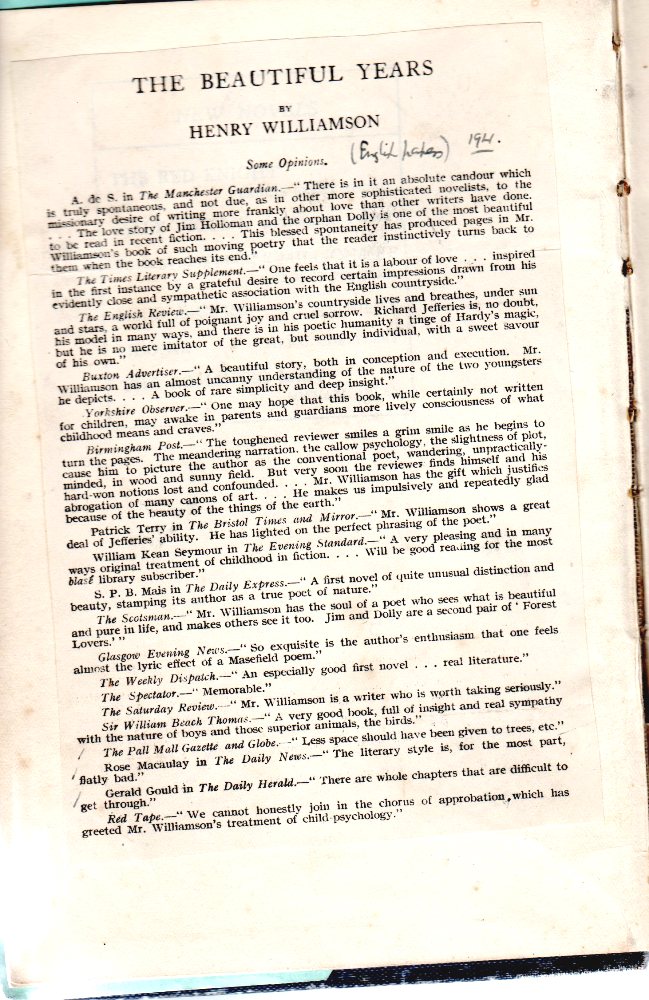
*************************
The scarce dust wrapper for the first edition, front and back:
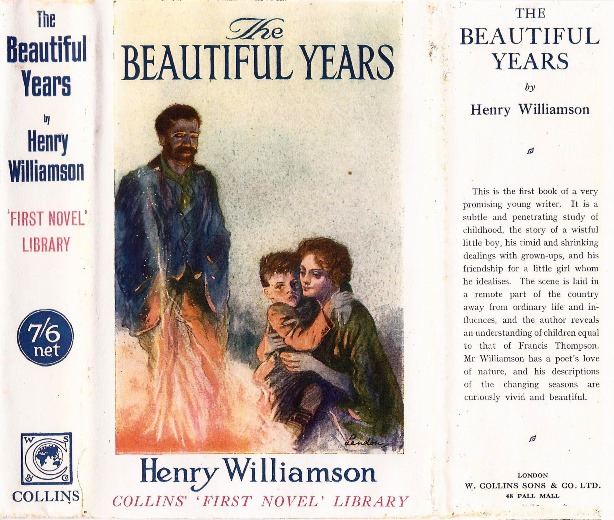
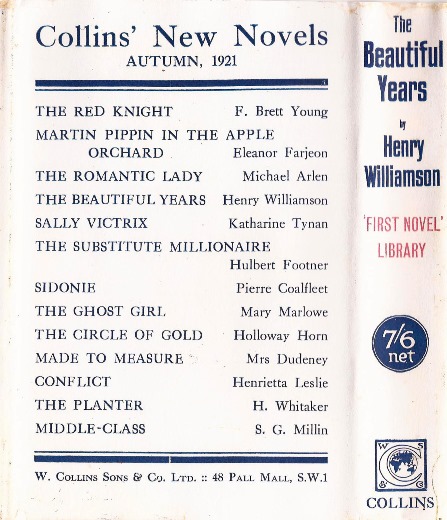
Other editions:
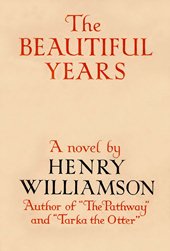 |
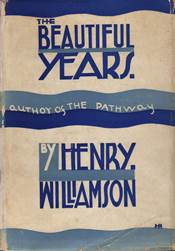 |
|
| Revised edition, Faber, 1929 | First US edition, Dutton, 1929 |
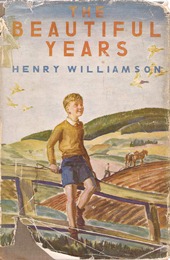 |
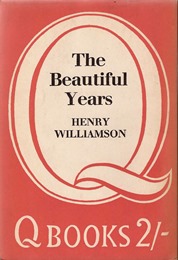 |
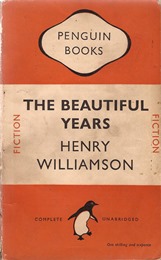 |
||
|
2nd impression (cheap edition) Faber, 1930 |
Wartime Q Books edition, Faber, 1942 |
Penguin, 1949 |
Some other covers of different editions of The Beautiful Years are shown at the bottom of The Flax of Dream page.
